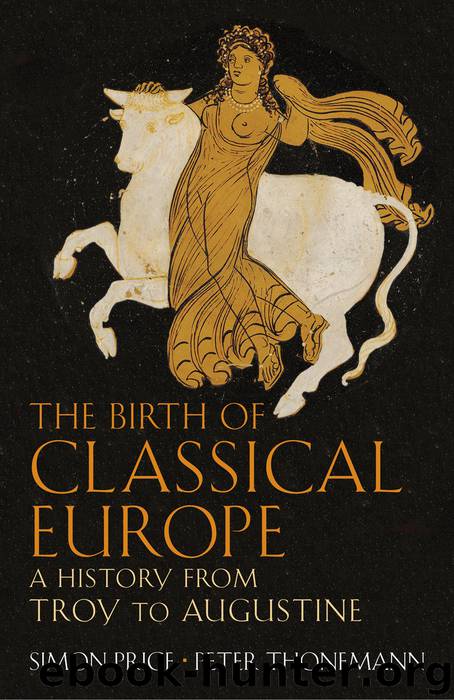The Birth of Classical Europe by Peter Thonemann

Author:Peter Thonemann
Language: eng
Format: epub
ISBN: 9780141946863
Publisher: Penguin Books Ltd
Published: 2010-03-25T16:00:00+00:00
Map 25. The western Mediterranean in the third and second centuries BC.
From a conscious Roman point of view, the explanation of Roman growth was much simpler. Romans held that their extraordinary success and prosperity were due to their uniquely close relations with the gods. In a telling letter of 193 BC, the Roman authorities replied to a request by the people of Teos (a Greek city on the west coast of Asia Minor) that they accept that the city and its territory be declared ‘holy’ and that the honours for the chief deity of Teos, Dionysus, be enhanced. The Romans gave a key reason for their decision: ‘the fact that we have, absolutely and consistently, placed reverence towards the gods as of the first importance is proved by the favour which we have received from them on this account.’ This fact the Romans believed to be well known to everybody. They saw themselves as fighting only ‘just wars’, and their victories as being due to the ongoing piety of the Romans towards the gods. People at the time and subsequently argued that there was more than this to Roman expansion, but this self-estimation of the Romans needs to be added to our explanations of what came to pass.
Major conflict between Rome and Carthage, the First Punic War, broke out in 264 BC. The trigger was trivial, but the struggle soon escalated to become one whose prize was control over all of Sicily, where the Carthaginians had long had their zone. In an early phase of the war, Segesta, a town in the Carthaginian zone of western Sicily, decided to massacre its Carthaginian garrison and go over to the Romans. The Segestans were influenced in this dangerous decision by their kinship with the Romans: they too were descended from Aeneas. A Segestan claim that their city had been founded by refugees from Troy is found as early as the fifth century BC. Here it has particular force because they knew it would dovetail with the Romans’ own claim about themselves, and it was to be repeated by Segesta on two coin issues in the first century BC.
Roman victory over Carthage and its ally Syracuse in 241 BC led to a humiliating peace for Carthage, and Roman expropriation of Sicily as its first overseas province. It is easy for us to see the First Punic War as a struggle between the two great western powers, driven by their own immediate imperatives. One of the combatants on the Roman side saw things rather differently. Naevius, in the first Latin epic on a Roman topic, a historical poem on the First Punic War, set the war in a much wider perspective. The poem began with the Romans fighting in Sicily, but then moved back in time, perhaps triggered by the Roman commander seeing representations of myths on a temple in Sicily. About a third of the poem was then set in the remote past, before returning to the present war: Aeneas fleeing Troy; Aeneas
Download
This site does not store any files on its server. We only index and link to content provided by other sites. Please contact the content providers to delete copyright contents if any and email us, we'll remove relevant links or contents immediately.
| Africa | Americas |
| Arctic & Antarctica | Asia |
| Australia & Oceania | Europe |
| Middle East | Russia |
| United States | World |
| Ancient Civilizations | Military |
| Historical Study & Educational Resources |
The Daily Stoic by Holiday Ryan & Hanselman Stephen(3110)
The Fate of Rome: Climate, Disease, and the End of an Empire (The Princeton History of the Ancient World) by Kyle Harper(2875)
People of the Earth: An Introduction to World Prehistory by Dr. Brian Fagan & Nadia Durrani(2619)
Ancient Worlds by Michael Scott(2493)
Babylon's Ark by Lawrence Anthony(2433)
Foreign Devils on the Silk Road: The Search for the Lost Treasures of Central Asia by Peter Hopkirk(2388)
The Daily Stoic by Ryan Holiday & Stephen Hanselman(2344)
India's Ancient Past by R.S. Sharma(2298)
MOSES THE EGYPTIAN by Jan Assmann(2275)
The Complete Dead Sea Scrolls in English (7th Edition) (Penguin Classics) by Geza Vermes(2135)
Lost Technologies of Ancient Egypt by Christopher Dunn(2111)
The Earth Chronicles Handbook by Zecharia Sitchin(2101)
24 Hours in Ancient Rome by Philip Matyszak(1973)
Alexander the Great by Philip Freeman(1961)
Aztec by Gary Jennings(1879)
The Nine Waves of Creation by Carl Johan Calleman(1784)
Curse Tablets and Binding Spells from the Ancient World by Gager John G.;(1768)
Before Atlantis by Frank Joseph(1740)
Earthmare: The Lost Book of Wars by Cergat(1715)
